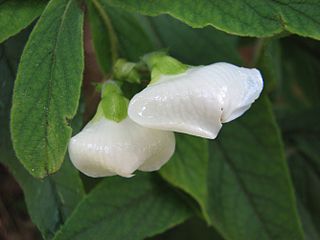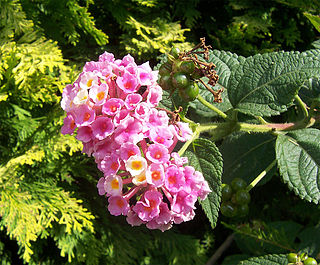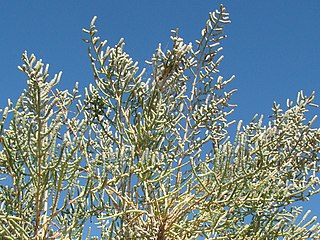| Campylostachys | |
|---|---|
| Scientific classification | |
| Kingdom: | Plantae |
| Clade: | Angiosperms |
| Clade: | Eudicots |
| Clade: | Asterids |
| Order: | Lamiales |
| Family: | Stilbaceae |
| Genus: | Campylostachys Kunth 1832 not E.Mey. 1843 |
| Species: | C. cernua |
| Binomial name | |
| Campylostachys cernua (L.f.) Kunth | |
| Synonyms [1] | |
| |
Campylostachys is a genus of flowering plants in the family Stilbaceae described as a genus in 1832. [2] [3]

The flowering plants, also known as angiosperms, Angiospermae or Magnoliophyta, are the most diverse group of land plants, with 416 families, approximately 13,164 known genera and c. 369,000 known species. Like gymnosperms, angiosperms are seed-producing plants. However, they are distinguished from gymnosperms by characteristics including flowers, endosperm within the seeds, and the production of fruits that contain the seeds. Etymologically, angiosperm means a plant that produces seeds within an enclosure; in other words, a fruiting plant. The term comes from the Greek words angeion and sperma ("seed").

Stilbaceae is a family of flowering plants in the order Lamiales.
There is only one known species, Campylostachys cernua, endemic to the Cape Province region of South Africa.

The Province of the Cape of Good Hope, commonly referred to as the Cape Province and colloquially as The Cape, was a province in the Union of South Africa and subsequently the Republic of South Africa. It encompassed the old Cape Colony, and had Cape Town as its capital. Following the end of the Apartheid era, the Cape Province was split up to form the new Eastern Cape, Northern Cape and Western Cape provinces, along with part of the North West.

South Africa, officially the Republic of South Africa (RSA), is the southernmost country in Africa. It is bounded to the south by 2,798 kilometres (1,739 mi) of coastline of Southern Africa stretching along the South Atlantic and Indian Oceans; to the north by the neighbouring countries of Namibia, Botswana, and Zimbabwe; and to the east and northeast by Mozambique and Eswatini (Swaziland); and it surrounds the enclaved country of Lesotho. South Africa is the largest country in Southern Africa and the 25th-largest country in the world by land area and, with over 57 million people, is the world's 24th-most populous nation. It is the southernmost country on the mainland of the Old World or the Eastern Hemisphere. About 80 percent of South Africans are of Sub-Saharan African ancestry, divided among a variety of ethnic groups speaking different African languages, nine of which have official status. The remaining population consists of Africa's largest communities of European (White), Asian (Indian), and multiracial (Coloured) ancestry.
- formerly included
now in Euthystachys Kogelbergia
- Campylostachys abbreviataE.Mey 1838 not E.Mey. 1843, syn of Euthystachys abbreviata (E.Mey.) A.DC.
- Campylostachys phylicoidesSond. syn of Kogelbergia phylicoides (A.DC.) Rourke
- names in Cyperaceae
In 1843, Meyer used the same name to refer to some plants in the Cyperaceae, thus creating an illegitimate homonym. Meyer's genus name and the species name he created in the genus are invalid as well as illegitimate, as they were published without descriptions. [4]

The Cyperaceae are a family of monocotyledonous graminoid flowering plants known as sedges, which superficially resemble the closely related rushes and the more distantly related grasses. The family is large, with some 5,500 known species described in about 90 genera, the largest being the "true sedges" genus Carex with over 2,000 species. These species are widely distributed, with the centers of diversity for the group occurring in tropical Asia and tropical South America. While sedges may be found growing in almost all environments, many are associated with wetlands, or with poor soils. Ecological communities dominated by sedges are known as sedgelands.
In biology, a homonym is a name for a taxon that is identical in spelling to another such name, that belongs to a different taxon.
- CampylostachysE.Mey. 1843 syn of Fimbristylis Vahl 1805
- Campylostachys abbreviataE.Mey. 1843 not E.Mey. 1838, syn of Fimbristylis ferruginea (L.) Vahl

Fimbristylis is a genus of sedges. A plant in this genus may be known commonly as a fimbry, fimbristyle, or fringe-rush. There are 200 to 300 species distributed worldwide. Several continents have native species but many species have been introduced to regions where they are not native. Some are considered weeds. These are typical sedges in appearance, with stiff, ridged stems and cone-shaped terminal panicles of spikelets. They are found in wet environments, and are most diverse in tropical and subtropical regions.

Fimbristylis ferruginea is a species of fimbry known by the common names rusty sedge and West Indian fimbry. The plant is common along the coast line and estuaries of Australia. It is also native to parts of Africa, southern Asia, and South America. The flowers are a distinctive rusty brown color appearing on a single spikelet from May to July.












